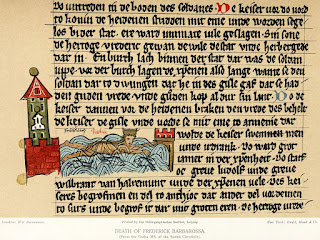The abbey started as a simple small house on a hillock in a marshy area, from which Bertin would go out and preach to the pagan Morini, a coastal tribe in northern France. A converted nobleman gave to bishop Omer a tract of land called Sithiu, which Omer turned over to Bertin for the abbey. Their numbers grew, and eventually a new abbey was built on the site which became surrounded by a town named Saint-Omer. (There were a few abbeys built over the years as their numbers grew. The most recent one was ordered demolished in 1830; its ruins can be seen in the illustration.)
So near the northern coast made Saint-Omer vulnerable to Vikings, who ravaged the place in the 860s and 880s, but the town rebuilt with strong walls. Saint-Omer became part of Flanders when Arnulf of Flanders conquered the county in 932. In 1127, its importance as a commercial center (thanks to its growing textile industry) earned it the first charter in West Flanders with city rights.
Saint-Omer became part of France (again) when Philip II of France (1165 - 1223) forced Count Ferdinand of Flanders to sign the Treaty of Pont-à-Vendin. Despite this, battle over that part of France continued. Ferdinand's alliance with King John of England and Emperor Otto IV did not help, and Saint-Omer remained within French boundaries, though it continued to be a significant part of the Flanders economy. Saint-Omer did not become permanently a French town until 1678.
Besides Lambert, another famous son of Saint-Omer was Godfrey of Saint-Omer, one of the founding members of the Knights Templar. The symbol of the Templars—two men riding a single horse, representing their vow of poverty—is supposedly because the first Grand Master, Hugues de Payen, and Godfrey were so poor that the two men had to share a horse.
I mentioned above that Saint-Omer was the first in the county to gain "city rights." What did that entail? I'll tell you tomorrow.




.JPG)


,_f._3r_-_BL_Loan_MS_88_3.jpg)










